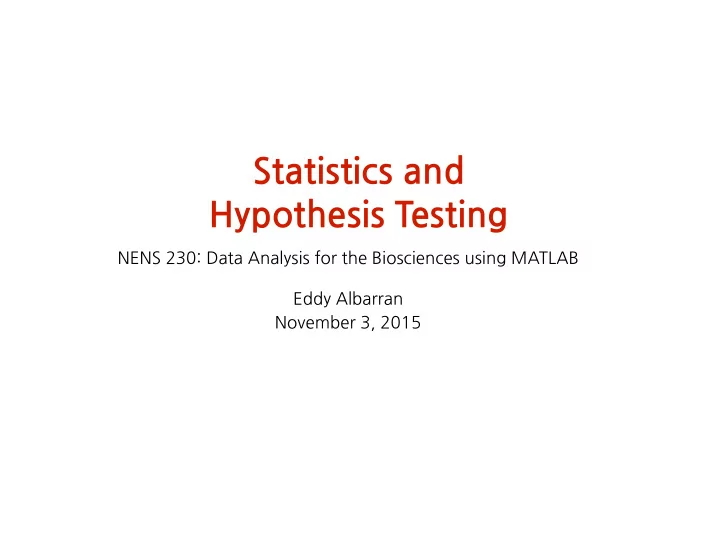

Statistics'and' Hypothesis'Testing NENS�230:�Data�Analysis�for�the�Biosciences�using�MATLAB Eddy�Albarran� November�3,�2015
Analysis�Methodology Data Exploratory�� Hypothesis�� Data�Analysis Testing • Summary�Statistics� • T-Test� • Dimensionality�Reduction/PCA� • Z-test� • Visualization�� • Chi-Square�� • Histogram� • etc. • Scatterplots� • Box�plots� • etc. Fail�to� Reject� reject�null Null Generate� Hypotheses
Outline Summary statistics functions Random Variables – Random variables, PDF, CDFs – Estimates of central tendency and dispersion – Standard error of the mean, confidence intervals Statistical Hypothesis Testing – Tests and significance – Student’s t test walkthrough – Other commonly used tests Analysis of Variance Homework
Summary Statistics Commonly used functions: – mean() – std() – var() – sum() – min() – max()
mean() �function mean() �computes�the�average�(sample�mean)�of�a� vector.�With�matrices,�you�need�to�specify�which� dimension�to�average�along.� mean(X, 1) �means�return�the�average�row� (average�across�the�rows).�This�is�the�default�if�you� only�specify�one�argument.� mean(X, 2) �means�return�the�average�column� (average�across�the�columns)
mean() �function mean() �computes�the�average�(sample�mean)�of�a� vector.�When�dealing�with�matrices,�you�need�to� specify�which�dimension�to�average�along. mean(X) Dim�2 mean(X, 1) evaluates�to 11.1 4 X = 26 0 mean(X, 2) evaluates�to 13 15 15 15 Dim�1 1 1 1 2.4 0 1.2
mean() �function mean() �operates�on�its�first�argument.�Be� careful�when�averaging�two�things�together� that�you�pack�them�in�a�vector�using� [ ] � mean(1, 5) evaluates�to� 1 “Take�the�mean�of� [1] �along�the�5th� dimension”� � mean([1 5]) �evaluates�to� 3
std() �function std() �computes�the�standard�deviation�of�a�list�of�numbers� — When�dealing�with�matrices,�you�need�to�specify�which�dimension�to�average� along,� as'the'third'argument.' � — The�second�argument�should�be� 0 �if�you�want�the�unbiased�estimator�that� normalizes�by� n-1 ,�where� n �is�the�number�of�samples std(X) Dim�2 std(X, 0, 1) evaluates�to 11.7604�� 7.3485 X = 26 0 std(X, 0, 2) evaluates�to 18.3848 15 15 0 Dim�1 1 1 0 2.4 0 1.6971
var() �function var() �computes�the�sample�variance�of�a�list�of�numbers� — When�dealing�with�matrices,�you�need�to�specify�which�dimension�to�operate� along,� as'the'third'argument.' � — The�second�argument�should�be� 0 �if�you�want�the�unbiased�estimator�that� normalizes�by� n-1 ,�where� n �is�the�number�of�samples.�(This�is�the�default) var(X) Dim�2 var(X, 0, 1) evaluates�to 138.31�� 54 X = 26 0 var(X, 0, 2) evaluates�to 338 15 15 0 Dim�1 1 1 0 2.4 0 2.88
sum() �function sum() �computes�the�sum�of�a�vector.�When� dealing�with�matrices,�you�should�specify�which� dimension�to�average�along.� sum(X, 1) �means�return�the�sum�over�rows�(sum� over�rows�within�each�column).�This�is�the�default�if� you�only�specify�one�argument.� sum(X, 2) �means�return�the�sum�over�columns� (sum�over�columns�within�each�row)
min() �function min() �computes�the�minimum�of�a�vector.�When� dealing�with�matrices,�you�should�specify�which� dimension�to�find�the�minimum�along.� min(X, Y) �means�return�an�array�the�same�size�as� X�and�Y�consisting�of�the�smaller�of�the�elements�in� X�and�Y�at�each�location.� min(X, [], 1) �means�return�the�minimum�value� in�each�column.�This�is�the�default�if�you�only� specify�one�argument.� min(X, [], 2) �means�return�the�minimum�in� each�row.
max() �function max() �computes�the�maximum�of�a�vector.�When� dealing�with�matrices,�you�should�specify�which� dimension�to�find�the�maximum�along.� max(X, Y) �means�return�an�array�the�same�size�as� X�and�Y�consisting�of�the�larger�of�the�elements�in� X�and�Y�at�each�location.� max(X, [], 1) �means�return�the�maximum�value� in�each�column.�This�is�the�default�if�you�only� specify�one�argument.� max(X, [], 2) �means�return�the�maximum�in� each�row.
Outline Summary�statistics�functions� Random'Variables' — Random'variables,'PDF,'CDFs' — Estimates'of'central'tendency'and'dispersion' — Standard'error'of'the'mean,'confidence'intervals' Statistical�Hypothesis�Testing� — Tests�and�significance� — Student’s�t�test�walkthrough� — Other�commonly�used�tests� Analysis�of�Variance� Homework
Discrete�random�variables Suppose�we�have�a�random�variable�X.� Discrete'random'variables' take�one�value�within�a� set�of�k�possible�values.� Probability'mass'function: �For�a�given�value�x i� returns�the�probability�p i� of�X�taking�that�value.� Pr [ X = x i ] = p i � � Sum�of�these�probabilities�must�be�1.�� p 1 + p 2 + · · · + p k = 1
Probability�Mass�Function
Continuous�random�variables Suppose�we�have�a�random�variable�X.� Continuous'random'variables' take�values�within� some�continuous�range�of�values.� Probability'density'function'(PDF): �integrating�this� function�over�some�interval�gives�you�the� probability�that�X�lies�in�that�interval.� Z b Pr [ a ≤ X ≤ b ] = f ( x ) dx � a Therefore,�the�integral�under�this�function�is�1.� Z ∞ f ( x ) dx = 1 −∞
Normal�distribution Normal�or�Gaussian�distributions�describe�many�naturally� occurring�phenomena,�due�to�the�central�limit�theorem.� Specified�by�two�parameters:� — Location'parameter: �the�mean�(μ)� — Scale'parameter: �the�standard�deviation�(σ) 1 e − ( x − µ )2 2 σ 2 p (2 π ) σ Source:�wikipedia.org
PDF�for�normal�distribution
Cumulative�distribution�function Cumulative'distribution'function'(CDF): �how�likely� is�X�less�than�or�equal�to�a�particular�value.� � Pr [ X ≤ x ] = F ( x ) � The�CDF�is�the�integral�of�the�PDF.�� The�PDF�is�the�derivative�of�the�CDF.�Therefore,�the� parts�of�the�CDF�with�the�steepest�slope�are�the� highest�points�of�the�PDF,�i.e.�where�most�of�the� values�lie.��
CDF�for�normal�distribution
Expected�Value The�expected�value�of�a�random�variable�is�it’s� mean.�You�can�calculate�the�expected�value�of�a� random�variable�X�by�taking�the�weighted�average� of�all�its�possible�values.�The�weights�are�the� probability�of�X�taking�each�value. E [ X ] = x 1 p 1 + x 2 p 2 + · · · + x k p k Discrete�RV: Z ∞ E [ X ] = xf ( x ) dx Continuous�RV: −∞
Sample�mean Sampling:' When�we�measure�some�quantity�in�an� experiment,�we�think�of�it�as�taking�samples�from�a� distribution.� Sample'mean:' By�taking�the�average,�we�are�estimating� the�mean�or�expected�value�of�the�underlying� distribution�which�generated�these�quantities.� A'central'problem'in'statistics:' How�close�is�this� estimate�of�the�mean�(the�average�of�our�samples)�to� the�true,�underlying�mean?
Standard�Error�of�the�Mean Suppose�we�make�N�measurements�of�X,�sampling� from�a�normal�distribution�with�mean� μ�and� standard�deviation�σ .�� If�we�take�the�average�of�these�N�samples,�our� estimate'of'the'mean'is'a'normal'distribution .� The�mean�of�this�sampling�distribution�is�μ� The'standard'error'is'σ'/'sqrt(N).' This�means�that�on�average,�our�estimate�will�be� correct.�The�spread�around�the�true�mean�shrinks� as�1/sqrt(N).
Standard�Error�of�the�Mean Suppose�we�make�N�measurements�of�X�which�may� or�not�be�normally�distributed.� If�we�take�the�average�of�these�N�samples,�our� estimate�of�the�mean� approaches �a�normal� distribution�as�N�gets�larger�(central�limit�theorem).� The�mean�of�this�sampling�distribution�is�μ� The�standard�error�is�σ�/�sqrt(N).�
Recommend
More recommend